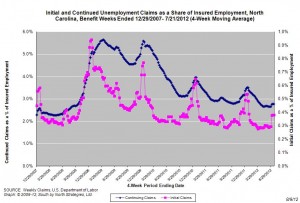Policy Points
09.08.2012
Policy Points
For the benefit week ending on July 21, 2012, some 10,208 North Carolinians filed initial claims for state unemployment insurance benefits and 100,385 individuals applied for state-funded continuing benefits. Compared to the prior week, there were fewer initial and fewer continuing claims. These figures come from data released by the U.S. Department of Labor.
Averaging new and continuing claims over a four-week period — a process that helps adjust for seasonal fluctuations and better illustrates trends — shows that an average of 14,332 initial claims were filed over the previous four weeks, along with an average of 104,530 continuing claims. Compared to the previous four-week period, the average number of initial claims was higher, as was the average number of continuing claims .
One year ago, the four-week average for initial claims stood at 13,365, and the four-week average of continuing claims equaled 113,152.
In recent weeks covered employment has increased and now exceeds the level recorded a year ago (3.8 million versus 3.7 million). Nevertheless, there are still fewer covered workers than there were in January 2008, which means that payrolls are smaller today than they were over four years ago.
The graph shows the changes in unemployment insurance claims measured as a share of covered employment in North Carolina since the recession’s start in December 2007. 
Both new and continuing claims appear to have peaked for this cycle, and the four-week averages of new and continuing claims have fallen considerably. Yet continuing claims remain at an elevated level, which suggests that unemployed individuals are finding it difficult to find new positions.
08.08.2012
Policy Points
Economic policy reports, blog postings, and media stories of interest:
08.08.2012
News Releases, Policy Points
CHAPEL HILL (August 8, 2012) – Earlier this week, the Employment and Training Administration, an agency within the US Department of Labor, released a research report entitled The Employment Service in Rural North Carolina: Insights from the “Great Recession.”
Prepared by South by North Strategies, Ltd., a research firm specializing in economic and social policy, the report explores the role that the 90 local offices of the North Carolina State Employment Service (ES) played in assisting the rural unemployed between 2007 and 2010.
Established in 1935, the ES was long part of the Employment Security Commission of North Carolina, which now is a component of the North Carolina Department of Commerce. The mission of the Employment Service is to provide publicly-funded labor exchange services to employed and unemployed workers and to firms seeking employees. The ES also manages unemployment insurance claims at the local level, administers the “work test” required of insurance claimants, and serves as a mandated partner in the state’s network of JobLink Career Centers. Employees and employers may access services remotely or at one of 90 local offices.
The study explores the role played by local ES offices in rural communities between 2007 and 2010, which was the height of the “Great Recession” in North Carolina. Attention centers on the popular policy argument that local ES offices ensure equal access to workforce services in rural communities. To that end, the study broke the policy argument into six distinct hypotheses and examined them quantitatively and qualitatively.
Specifically, the study documents the evolution of North Carolina’s service model, analyzes administrative data pertaining to service usage, and solicits stakeholder perspectives through semi-structured interviews. The study concludes by offering program recommendations and suggesting avenues for future inquiry.
The Employment and Training Administration commissioned the report as part of the 2010 Employment and Training Administration Research Papers Program, which competitively awarded funding to conduct original research and prepare scholarly papers on topics relating to the workforce investment system. Full descriptions of the program and all the funded research projects are available in federal Training and Employment Notice #3-12.
08.08.2012
Policy Points
From the Economic Policy Institute’s analysis of the June version of the Job Openings and Labor Turnover Survey (JOLTS) …
The June Job Openings and Labor Turnover Survey (JOLTS), released today by the Bureau of Labor Statistics, provides evidence that the recovery continues to edge in the right direction. While job openings in June increased by 105,000, unemployment that month increased by 29,000 …. This means that the “job-seekers ratio”—the ratio of unemployed workers to job openings—fell slightly (by one-tenth), to 3.4-to-1.
…
The ratio has been slowly but steadily improving since reaching its peak of 6.7-to-1 in summer 2009. However, the odds are still stacked strongly against job seekers; a job-seekers ratio above 3-to-1 means that for more than two out of three unemployed workers, there simply are no jobs. In fact, the job-seekers ratio is still above the high point in the last business cycle of 2.9-to-1 in September 2003.
07.08.2012
Policy Points
Economic policy reports, blog postings, and media stories of interest:


 Email Sign-Up
Email Sign-Up RSS Feed
RSS Feed